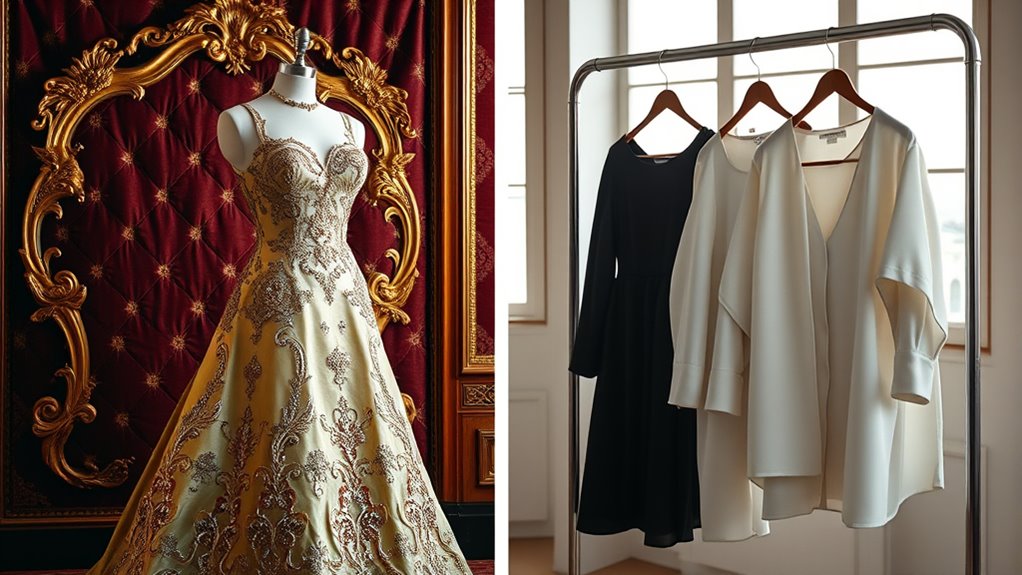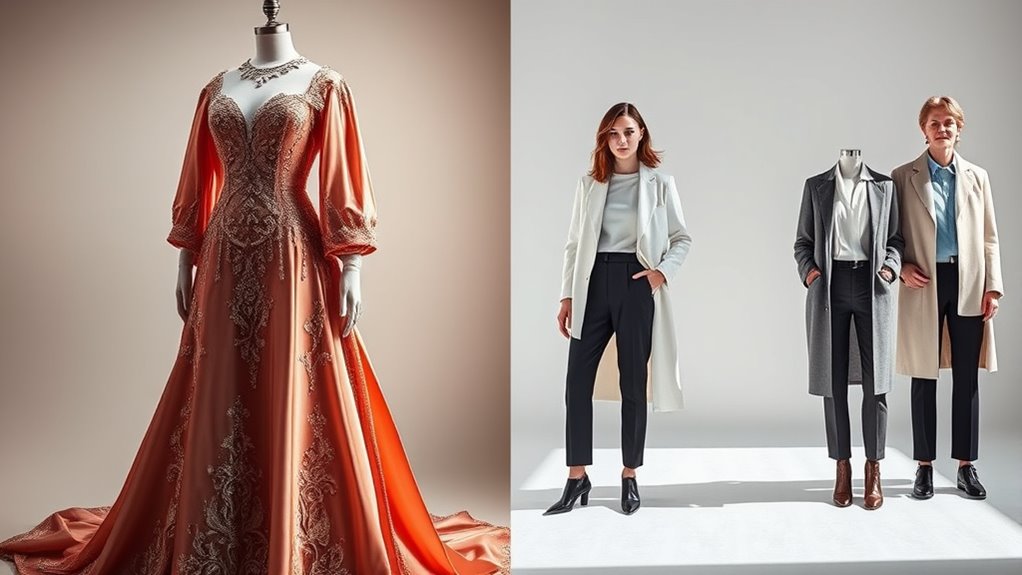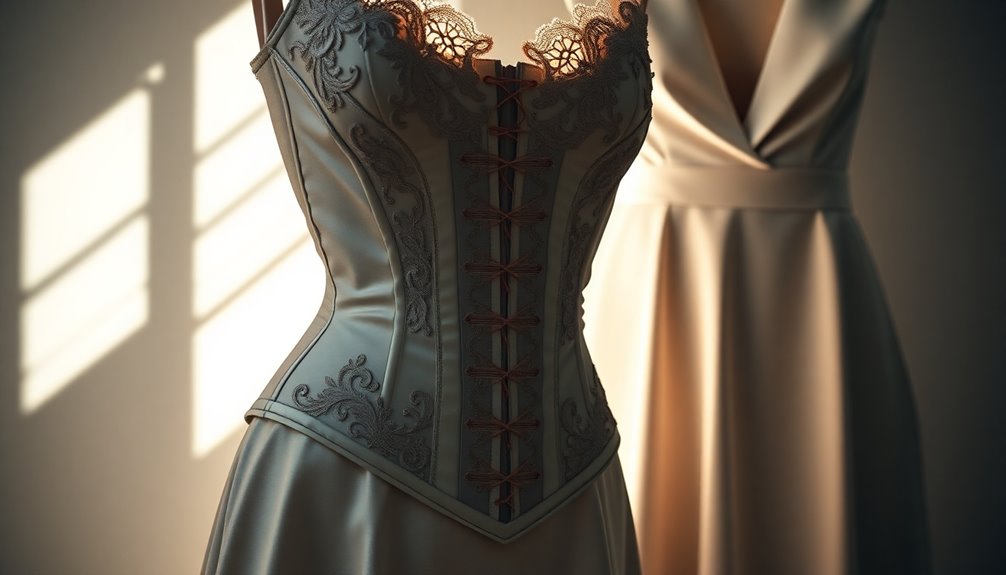Couture and prêt-à-porter differ mainly in how they’re made and who they’re for. Couture involves handcrafting exclusive, one-of-a-kind garments tailored just for you, often taking weeks or months and using luxurious materials. Prêt-à-porter, on the other hand, is mass-produced for everyday wear, focusing on efficiency and affordability. If you want to understand how these two worlds shape fashion’s landscape, you’ll uncover more details ahead.
Key Takeaways
- Couture is handcrafted, bespoke, and highly exclusive, while prêt-à-porter is mass-produced and accessible.
- Couture garments involve intricate details and extensive artisan work; prêt-à-porter focuses on efficiency and standardization.
- Couture serves as artistic expression and innovation; prêt-à-porter balances style with practicality and trendiness.
- Couture is expensive and rare, emphasizing craftsmanship; prêt-à-porter is more affordable and widely available.
- The production scale and techniques directly influence the exclusivity, pricing, and purpose of each fashion segment.

When it comes to high fashion, understanding the difference between couture and prêt-à-porter is essential, especially if you’re looking to make informed choices or appreciate the artistry behind each. Couture, by definition, involves clothing that’s meticulously handcrafted to fit the individual client perfectly. Every stitch, seam, and embellishment reflects an extraordinary level of handmade craftsmanship. These pieces are often created over weeks or even months, with skilled artisans dedicating countless hours to ensure each detail is flawless. In contrast, prêt-à-porter, or ready-to-wear, is produced on a much larger scale, utilizing mass production techniques that enable brands to manufacture clothing efficiently and in high volume. While prêt-à-porter collections still involve a significant amount of design and quality control, they lack the bespoke element that defines couture.
Understanding these production processes helps clarify why couture pieces command such high prices and are considered works of art. Couture houses invest heavily in craftsmanship, employing skilled seamstresses, embroiderers, and pattern makers who often work by hand. This handmade craftsmanship results in garments that fit like a second skin and feature intricate details impossible to achieve through automation. Many couture pieces are customized for each client, with fittings and adjustments throughout the process to ensure a perfect fit and unique design. Conversely, mass production techniques rely on industrial machinery, standardized patterns, and assembly lines. This approach allows prêt-à-porter to be more accessible and affordable, but it can’t replicate the personalized touch or the level of detail found in couture. Additionally, the production scale significantly impacts pricing and availability, making couture pieces highly exclusive.
If you’re browsing fashion, recognizing these differences can help you appreciate the artistry behind each piece. Couture is about exclusivity, craftsmanship, and artistic expression, often showcasing innovative techniques or luxurious materials. It’s designed to push the boundaries of fashion, serving as a platform for designers to experiment and create timeless masterpieces. Prêt-à-porter, on the other hand, aims to balance style with practicality, offering seasonal collections that are wearable and accessible. It’s driven by trends and consumer demand, with production methods optimized for efficiency and consistency. Knowing this, you can better understand why couture pieces carry a sense of rarity and artistry, while prêt-à-porter offers the latest styles at a more approachable price point. Both have their place in the fashion world, but each serves a different purpose rooted in their distinct production philosophies.
Frequently Asked Questions
How Do Couture and Prêt-À-Porter Influence Mainstream Fashion Trends?
You’re influenced by how couture and prêt-à-porter shape mainstream fashion trends through luxury branding and celebrity endorsements. Couture sets the high-end, exclusive standards, inspiring prêt-à-porter collections that are more accessible. When celebrities wear these designs, it amplifies trends and makes luxury fashion desirable. This cycle helps mainstream brands adopt high-fashion elements, making runway styles popular and shaping your everyday wardrobe with a touch of glamour.
What Are the Environmental Impacts of Couture Versus Pret-À-Porter?
Ever wonder how fashion choices affect the environment? Couture often involves sustainable practices and eco-friendly materials, but its small scale limits overall impact. Pret-à-porter, produced in larger quantities, can contribute more to waste and pollution unless brands adopt eco-friendly materials and sustainable practices. Your choices in supporting eco-conscious brands can help reduce environmental impacts, encouraging the industry to prioritize sustainability across all fashion levels.
How Accessible Are Couture Designs to Average Consumers?
You might think couture is completely out of reach, but some designers are making efforts to increase mass accessibility without losing luxury exclusivity. While couture remains highly exclusive due to its craftsmanship and price, limited editions and collaborations are opening doors for more consumers. Still, most couture designs stay reserved for the elite, making true accessibility challenging. You’ll find pret-à-porter offers a more affordable, widely available alternative for stylish, luxury-inspired looks.
What Is the Typical Production Timeline for Couture Compared to Pret-À-Porter?
You’ll find that couture production takes considerably longer than pret-à-porter. Couture involves handcrafted techniques, with artisans meticulously shaping each piece over months, often using rare, carefully sourced materials. In contrast, pret-à-porter lines focus on faster, more streamlined manufacturing processes, allowing for quicker delivery. This dedication to craftsmanship and material sourcing in couture makes it a highly personalized, time-intensive process, unlike the more industrial, mass-produced nature of pret-à-porter.
How Do Pricing Strategies Differ Between Couture and Pret-À-Porter Collections?
Think of your wardrobe as a garden—luxury branding and customer exclusivity bloom differently in couture and pret-à-porter. Couture’s pricing is like rare, hand-carved sculptures, reflecting meticulous craftsmanship and limited availability, targeting elite clients. Pret-à-porter offers more accessible pricing, like cultivated flowers, appealing to a broader audience. You see, couture commands higher prices through exclusivity, while pret-à-porter balances quality and affordability to reach more customers.
Conclusion
Understanding the divide between couture and pret-a-porter helps you appreciate fashion’s artistry and accessibility. Did you know that only about 4,000 people worldwide can afford true haute couture? This statistic reminds you that couture remains exclusive, while pret-a-porter offers more everyday wear. Whether you’re drawn to the craftsmanship of couture or the practicality of pret-a-porter, both shapes the fashion industry in unique ways. Embrace what resonates with your style and appreciate the beauty behind each.









